|
|
Post by onlymark on Jan 31, 2012 18:27:46 GMT
tod, I have to give you a clue about something.
If you ever read anything I've written about plants/flora, then it'll be made up.
I don't have the foggiest idea about them but I find it easy enough to sound like I do.
|
|
|
|
Post by Deleted on Jan 31, 2012 18:55:15 GMT
Mark does have the bad seed, however.
|
|
|
|
Post by tod2 on Feb 1, 2012 4:56:22 GMT
Mark....you leg puller you! I wondered why I couldn't find any reference to it on the Net  I will find out the correct name and let you all know ;D |
|
|
|
Post by onlymark on Feb 1, 2012 5:01:18 GMT
I thought the reference to a circumcised penis might give it away.
|
|
|
|
Post by mickthecactus on Feb 1, 2012 13:04:17 GMT
Tod, you didn't fall for that did you?
And you, a woman of the world.................
|
|
|
|
Post by tod2 on Feb 1, 2012 13:51:15 GMT
I did! I did! But just you wait 'enry 'iggins! Just you wait  |
|
|
|
Post by onlymark on Feb 1, 2012 14:43:24 GMT
I promise I wont do it again.
Too often.
|
|
|
|
Post by tod2 on Feb 1, 2012 18:55:30 GMT
|
|
|
|
Post by Deleted on Feb 1, 2012 19:27:25 GMT
This last set of photos gives a really excellent idea of your lovely environment.
The shop is really amazing, much nicer than any shop in France that would sell similar goods.
I have a couple of questions about the schools that you showed. Is the only difference between the Afrikaans schools and the other schools the language of instruction, or is there also a "political" element involved?
And are same-sex schools like the school your son went to still common in South Africa?
|
|
|
|
Post by tod2 on Feb 1, 2012 20:10:36 GMT
Thank you Kerouac  It is quite a large selection of everything to do with sewing and a few crafts as well. I don't keep wool - no space. The upstairs storeroom is as large as the downstairs but not worth a photo. All the upright metal frames displaying rolls of fabric and reels of ribbons & lace, the shelving on the walls and ceiling, work tables etc., were made by my husband. Now the school question. Yes, the only difference is the language of instruction. Same sex schools are all private school institutions. All government schools have mixed pupils as far as I am aware. Kwazulu-Natal is known for it's fabulous privately run schools. The high schools like Hilton College, where my son went after Cordwalles, is on a par with Eton. www.hiltoncollege.com/Kerouac, scroll down to 'Vacancies' and click on French Teacher ;D |
|
|
|
Post by tod2 on Feb 8, 2012 14:18:02 GMT
Back in the centre of town and time to look at a little history of the city by viewing some monuments and the old cemetery. Back at the city hall and right opposite is a garden area of sorts which has three monuments: The first is dedicated to soldiers of the Zulu Wars:        That is what the monument looks like today, but here is an interesting link to it's inauguration with photos: samilitaryhistory.org/vol101mc.htmlThe second monument is the Natal Volunteers' Monument commemorating Natal colonists who died fighting in the South African War (1899 - 1902) presents in a very concrete form a particular interpretation of the war and of those who died fighting in it on the side of Great Britain.  Here are the four panels around it:     The interesting history and detail of each panel, especially if you are British, is explained very well in this link: tinyurl.com/7f2zo64The third monument to soldiers of the first and second World Wars, is an arch forming the entrance to the gardens and will be added here later... Next to the memorial garden, and opposite the city hall, is the Tatham Art Gallery.  About the Tatham Art Gallery The Gallery owes its origins to Mrs Ada Susan Tatham who collected donations early in 1903 and purchased works in Britain later that same year. After an initial exhibition the collection was first housed in the Pietermaritzburg City Hall. In 1923 the collection was greatly enhanced through the donations of Lieutenant Colonel R.H. Whitwell. The Tatham Art Gallery forms part of the Msunduzi Municipality and is governed by a Board of Trustees. Beginnings of the Tatham Art Gallery The beginnings of the Tatham Art Gallery, one of seven major art museums in South Africa, date back to the turn of the century when interested citizens of Pietermaritzburg presented the City Council with paintings. In 1903 a discussion relating to the formation of an art gallery was recorded in City Council minutes. A leading figure in these early negotiations was Mrs Ada Tatham, wife of the then Judge President of Natal, and after whom the Gallery is named. Mrs Tatham collected money from friends interested in the formation of an art gallery and from the City Council and traveled overseas to acquire art works. In England she contacted her husband's cousin, the President of the Royal Academy, and met other Royal Academicians. With their help and their interest in the founding of an art gallery in an English colony, Mrs Tatham managed to acquire paintings of a value in excess of what she had to spend. Note: The Cape Dutch house behind my home is the original Tatham residence. The land on which we built our home, and where we have lived for 34years, is built on the lower garden of the Tatham home. I have inherited two 100 year old palm trees which stood either side of the garden steps leading to a fish pond. The trees are still part of my back garden but I had to do away with the pond. The adjoining property to my home (and which was part of the original Tatham land) was owned by Judge Tatham's son before he sold it to my son, and is now owned by our family trust. The entire Tatham estate has been sub-divided into smaller plots over the years and sold off. Standing in front of the city hall, opposite the Tatham Gallery, is a May hedge (I think). It forms the boundary onto the street of the Natal Carbineer Gardens.      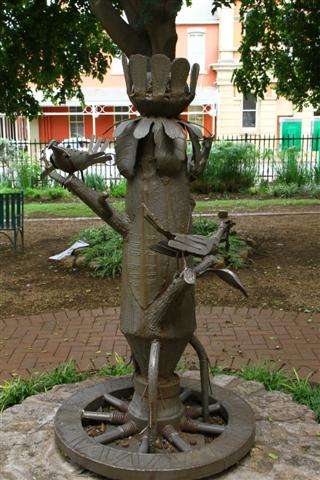   On to the old Voortrekker Cemetery: But first a few words........ www.pmbhistory.co.za/?showcontent&global%5B_id%5D=78   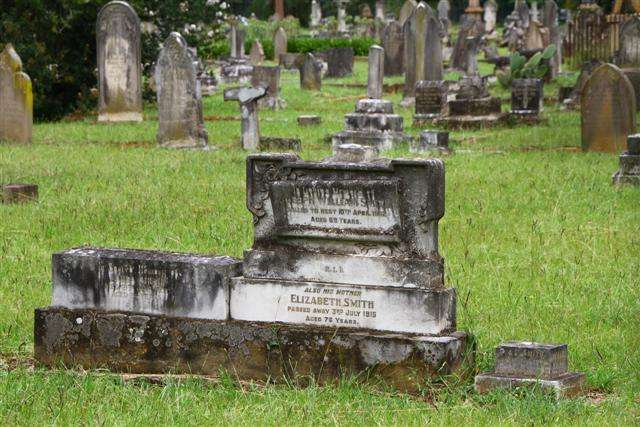  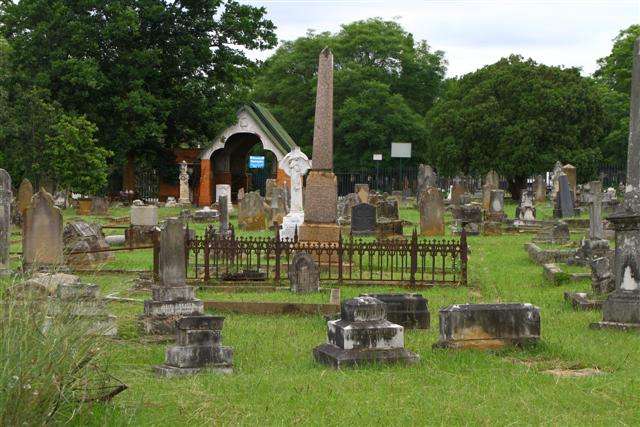  This old graveyard is in two sections. The main road into Pietermaritzburg divides the cemetery. These photos are of the right hand side as you come into town. I believe I have a distant relative buried in the other part of the cemetery. A boy who died in his younger years from measles and whooping cough. I will try and find his grave but unfortunately the cemetery is locked and I will have to seek permission to enter. The photos taken here were possible because we got through a break in the fencing. The reference : " Maritzburg's non-Christians were banished to a burial ground which was set aside on the Town Hill in 1863. In 1896 this latter cemetery was reduced in area to make way for suburban growth on the hill, and builders unearthed unmarked graves and skeletons in the process" This is the cemetery at the mosque I posted photos of. As a matter of fact my hairdresser is in the building which was constructed on top of the original old buriel ground. I think the bones were removed and re-buried in the graves in my photos - but I'm not sure. |
|
|
|
Post by nycgirl on Feb 8, 2012 15:29:38 GMT
The cemetery is lovely. It's too bad you can't enter freely.
Nice photos of the monuments. I also love the reddish-orange city hall building with the clock tower.
|
|
|
|
Post by bixaorellana on Feb 8, 2012 16:00:58 GMT
Oh Tod -- I looked at and admired the previous set of pictures, then somehow failed to comment on them. What a great, intimate glimpse that section is. It's really like visiting with you and being taken around. What really surprised me was your store, since to my American ears "shop" sounds like a small, possibly one-room enterprise. No wonder you and your husband work so hard there -- that's quite a business.
I loved riding in the car with you from work to home. It's so beautifully green where you live. How wonderful that a capital city kept itself from turning into concrete sprawl.
Your most recent posting is totally fascinating in a completely different way. Thanks for supplying all the background information. After reading it, I need to ask about the present-day attitude to the monuments. Are there people in favor of removing them completely, or of adding some kind of "historical perspective" markers near them?
You point out that the Tatham Art Gallery is now part of the municipality. Is the collection still being augmented?
I'm amazed by the view from in front of the city hall down the street. Pietermaritzburg somehow manages to keep the feel of a much smaller town even though it's rather a stately city. There's none of that bleak feeling of many downtowns, with too much concrete, grafted-on facades, and clunky looming slabs of buildings.
Thanks to you & your partner in crime for sneaking into the cemetery & getting those lovely pictures. It reminds me very much of the one in my home town, especially the photo with the iron fence and the obelisk.
|
|
|
|
Post by tod2 on Feb 8, 2012 16:34:23 GMT
Nycgirl - Yes, it is an amazing building. According to "Ripley's Believe it or Not" The Victorian and Edwardian building is the City Hall. Built in 1893, it was destroyed by fire in 1898, rebuilt, and reopened in 1901. Considered the largest all-brick building in the southern hemisphere, it stands on the site of the original Voortrekker Raadsaal, and was declared a national monument on 27 June 1996.
That must mean that the architect really had a most extraordinary vision way back in those old times!! The southern hemisphere - including Australia!? Wow!
Bixa - I cannot answer that. I would imagine that some of the collection is still being augmented but to what degree ?? Finance for that kind of thing is never easy to come by. Not long ago our Municipality was broke....
As for removing monuments...Mmmm, that has happened in Pretoria where radical eliments got their way before anything could be done. I don't hold much hope for the next 100 years.
To whom it matters - the people are a dying breed and the present young people have no interest in heritage. It's as foreign to them as the stars in our galaxy.
|
|
|
|
Post by onlymark on Feb 8, 2012 17:51:31 GMT
Fascinating.
Tod, firstly. the tinyurl link doesn't work for me. Is it just me?
Secondly, is there a monument anywhere (anywhere at all) dedicated to the Zulus that fought?
Thirdly, and somewhat controversially, as far as I remember (and I really ought to look into this) but the war memorial is dedicated to those of the Natal Native Contingent and Natal Native Horse that fought in the Zulu wars - but at the battle of Rorke's Drift - they ran off before the fighting started (or in the case of the Horse, rode off).
|
|
|
|
Post by tod2 on Feb 9, 2012 4:23:54 GMT
|
|
|
|
Post by onlymark on Feb 9, 2012 5:06:28 GMT
Yep, thanks.
|
|
|
|
Post by tod2 on Feb 9, 2012 5:39:20 GMT
Mark, I found this as well:
Ncome/Blood River Monument.
A monument was erected on the site of the battle in 1947, consisting of an ox wagon executed in granite by the sculptor Coert Steynberg. In 1971 a laager of 64 ox wagons cast in bronze( by Unifront Foundry in Edenvale- Fanie de Klerk and Jack Cowlard) was erected, and unveiled on 16 December 1998.
The Ncome monument on the east side of the river commemorates the fallen Zulu warriors. While the Blood River Memorial is associated with Afrikaner nationalism, the Ncome monument was intended as a symbol of reconciliation, but has become connected with Zulu nationalism.
At the 16 December 1998 inauguration of the most recent version of the monument, the Zulu politician and then Minister of Home Affairs, Mangosuthu Buthelezi, apologized to the Afrikaner nation for the death of Piet Retief and the subsequent suffering. At the same time Buthelezi also noted the suffering of the Zulu under British Colonial and Afrikaner rule during apartheid. He stressed that South Africans needed to consider the day as "a new covenant which binds us to the shared commitment of building a new country."
Today two complexes mark the battle site: the Ncome Monument and Museum Complex east of the Ncome River, and the Blood River Monument and Museum Complex to the west.
I have visited both. The Blood River laager of ox-wagons is a sorry sight. Apart from the main ring of wagons there was a centre marker of some description which has fallen to vandalism and could be restored if anyone cared about tourism.
The road to the site is extremely poor. I could understand the grass being left to grow wild and tall ( as I suppose the Voortrekkers found it) but the whole place needs a bit of sprucing up.
For a start it would be an idea to wend a walkable pathway to the Blood River itself to see where all the killing took place.
At the moment you would be unwise to attempt the walk because of puff-adders and other poisonous snakes.
We then drove ( why can't they link the two across the river?) to the Ncome Monument which is constructed like a group of Zulu Kraals (domed grass huts). The staff were friendly but unenthusiastic. The monument looks almost bare with few artifacts scattered around. Pity really, with some initiative the two could be a nice historic experience, instead of a disappointment.
|
|
|
|
Post by onlymark on Feb 9, 2012 6:05:48 GMT
Super. I just had a long read about the Blood River battle and it makes interesting reading (for me anyway). That about answers it then, there is at least one monument to them.
|
|
|
|
Post by mickthecactus on Feb 9, 2012 13:20:30 GMT
tod, just had time at last to look at this in some depth. It really is superb and you get the impression of actually being there. As Mark is mentioning there is a huge amount of history here and I really must make an effort to read up about it before it drops off the rader. As you say, I don't have much hope for the monuments surviving. I love the film Zulu (second only to Wizard of Oz). Wonder how accurate it was? I know that Henry Hook was badly portrayed and some years back Sothebys London had an exhibition of the VC's that were won. www.rorkesdriftvc.com/ |
|
|
|
Post by onlymark on Feb 9, 2012 18:27:42 GMT
There are going to be inaccuracies in any film but I do think Zulu stayed fairly true. I know there were a lot less Welsh there than portrayed for example but the impression you get of the senseless slaughter is conveyed well. As regards the VC's there was debate at the time whether to award them or not because some felt the soldiers either fought bravely or died, they had no choice in the matter, thus it wasn't seen as a voluntary act of bravery as most other awarded VC's.
The attack was against the orders of the Zulu King, which wasn't made clear in the film, and the King in the film was actually the great grandson of the actual King himself.
Anyway, just to hijack the thread for one last thing - one of my mostest, bestest, most favouritestest bits of cinema (as with mick) is the film and especially the closing battle with the Zulu impi trying to scare the shit out of the poor beleaguered British garrison who felt their time had come (especially bear in mind that they'd just received news that the main army of soldiers had had the crap kicked out of them at Isandlwana by the same Zulus, decimating the British forces).
Imagine standing behind a poorly built barricade, outnumbered many to one, waiting for the attack you know will come, not knowing if you'll survive even the first charge, knowing you are dealing with an 'enemy' with a bad rep.
The Zulus then form up and start to chant and challenge -
Sorry tod, got carried away there.
|
|
|
|
Post by Deleted on Feb 9, 2012 19:19:07 GMT
I remember seeing Zulu as a young boy, and it impressed me considerably. I am glad that I saw certain movies from other cultures back then, because there were not a huge number of them available where I lived. (Divorce Italian Style, Georgy Girl and Blow Up are also engraved in my mind from that period.)
The cemetery photos are exceptional, tod2, and perhaps all the more notable because of the idea of a little bit of Europe having been reproduced so far from "home." While it cannot be denied these days that both the Boers and the English did not go about settling the area in a culturally sensitive manner (no culture did so in those days), they didn't do it because they were nasty people but simply because they were trying to create a new home. And that's pretty much the same way that things took place in the United States and Canada, but the local original residents did not have the means to resist as much.
|
|
|
|
Post by tod2 on Feb 11, 2012 16:50:01 GMT
Every city has one...... Well, at least I think they do! This is our Agricultural Showgrounds - I pass by here at least four times a day and it is the alternative route home to the one I showed you up my "rue Lepic" - actually Cordwalles Drive. No flags flying at the moment because our Show is from 25 MAY TO 3 JUNE 2012. The agricultural show was inaugurated in 1895 and moved to the present showgrounds in 1902. With the assent of King Edward VII, the Society was granted ‘Royal’ status in 1904 and has been called The Royal Agricultural Show ever since. Even with the Union of South Africa now becoming a Republic, the show has proudly held it's Royal status.  The original arched entrance is still visible.    Here is a 360 of the grounds and surrounding area: www.royalshow.co.za/Royal_Showgrounds.htmlI think this aerial view will start off showing a large shunting yard next to the showgrounds. A darkish dirt road on the otherside of the tracks is a great vantage point when the fireworks are displayed at the beginning and end of the annual show. As the camera swings around the red arrow pointing to 'Fairground' reveals a motor bridge over the train tracks - right next to the bridge you may just make out a beige roof, a pale green roof and a grey roof building. This is the grey roofed building and is in Victoria street. It is a business run for the horsey crowd in town.   Mosey back into the town centre and this historic lane joins two main streets, namely Longmarket and Loop or more recently LANGALIBALELE STREET and JABU NDLOVU STREET.  In this lane are the old swimming baths used my none other than my own dear mum when a young school girl!    The Buchanan Street Baths, as they are named, have seen better days and are in sore need of upkeep. However, I was pleased to see everything is original! The old change booths still have the original hooks to hang you towel or clothes on.   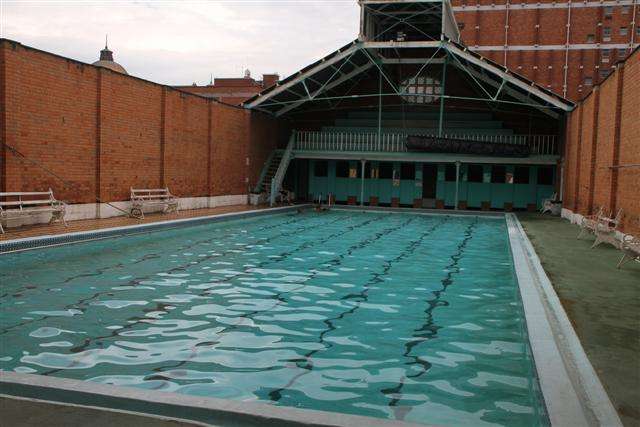      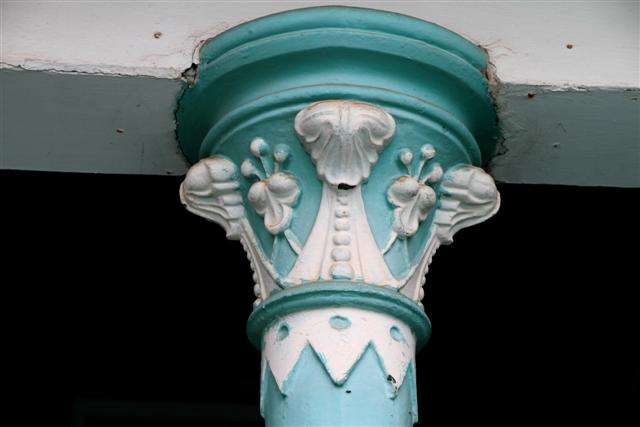 Facing down to the shallow end I see three young boys playing "catch" and having a wonderful time on this hot afternoon.     I was astonished to see the original tiles throughout the entire pool and building. Unfortunately the original benches are looking very bad and worn out. I wouldn't chance trying to sit on one!   As I left I took a snap of the ticket office at the entrance.  The nice young attendant let me go into his office and photograph the plaque on the opposite wall through his ticket 'hatch'.  He then pointed out this very old faded photo of the "Seals" swim team at a gala. I think the date is 1923, and it looks like a roof covered the entire pool. 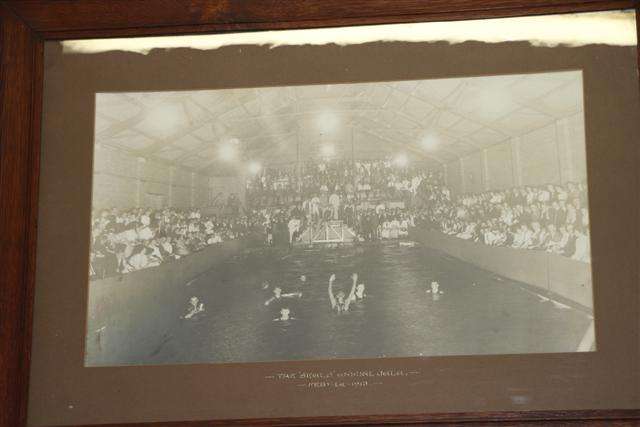 And a sketch by a local artist -  Just before leaving I asked the pool attendant why the place looks so run-down. He replied they keep asking for upkeep but nothing from the municipality has been forthcoming. I aim to take this situation up with the Mayor and will be going to our local newspaper with these photos. I don't know if it will help any but more people in the city need to know the state of the baths before they entirely go to wrack and ruin. I shot along to the main pool this morning and took a few quick photos just so you can compare.  Entrance.   Pointing the camera over the wall - In the background our tallest block of apartments.   |
|
|
|
Post by mich64 on Feb 11, 2012 19:20:19 GMT
Tod, this whole report has been outstanding. I have enjoyed every moment of it thus far. I do hope that you take the photos of the baths to your Mayor or Town Council so that attention will be made to this historic place. Even so, the employee's do seem to take care of what they can and it still looks inviting.
We do not have an Agricultural Fair building in our small city. In the fall season, the small communities around our city have Agricultural Fairs that host horse ploughing / pulling events, crops, preserves, pies, meat all for sale and viewing of prize winning horses, cows and pigs. They are usually hosted on the townships largest farm and in the evening there is usually some kind of music/dance along with a corn roast. I have not been to one since I was a child, makes me want to attend one this fall!
Really enjoying all the historical facts and photos Tod.
Cheers!
Mich
|
|
|
|
Post by Deleted on Feb 11, 2012 20:19:26 GMT
Great to see the municipal baths which on the inside at least (but not at all the outside) look almost identical to all of the old ones in Paris. Of course due to the "big city" status of Paris, the changing rooms are generally found on all sides (and usually two levels) of the pool -- but I absolutely recognize the style, the hooks, the tiles....  |
|
|
|
Post by tod2 on Feb 12, 2012 6:51:21 GMT
Sorry folks, I should have said at the beginning that the Buchanan Street Baths are the oldest in PMB but although a municipal pool, are not THE large municipal pool just a short distance away from the Voortrekker Cemetery - in other words, as you leave or enter the city.
There is also another covered pool nearer my end of town but I think it may be privately owned. It's called the Jolliffe Swimming Pool and used almost exclusively for school children that do not have a school swimming pool and swimming coaches. It is not heated but in winter the Buchanan Street pool is.
|
|
|
|
Post by bixaorellana on Feb 12, 2012 13:35:16 GMT
The Baths are completely fascinating, from the surprisingly homey porch outside to their wonderful interior turquoise paint. That's a really super picture of the two little boys playing at the end of the pool. Good for you for taking on the challenge of having the place fixed up. It's shocking that something as basic as the benches has not even been dealt with.
What are the Ag Showgrounds used for when there's no Agricultural Show going on?
|
|
|
|
Post by tod2 on Feb 12, 2012 13:52:56 GMT
Oh yes, Bixa. There is a wedding just about most weekends and the Members Dining room (at show times called The Royal Grill ) is used for receptions, orchid shows, and various get-to-gethers. At the moment the main arena has a monstrous white marquee laid out so probably some government or municipal function.
|
|
|
|
Post by tod2 on Feb 13, 2012 11:51:29 GMT
|
|
|
|
Post by mickthecactus on Feb 13, 2012 17:30:02 GMT
Great to see the municipal baths which on the inside at least (but not at all the outside) look almost identical to all of the old ones in Paris. Of course due to the "big city" status of Paris, the changing rooms are generally found on all sides (and usually two levels) of the pool -- but I absolutely recognize the style, the hooks, the tiles....  And London.......... |
|